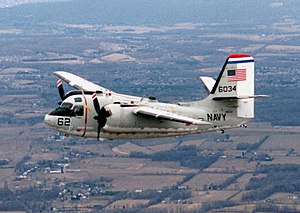Grumman C-1 Trader
| C-1 Trader | |
|---|---|
 |
|
| A C-1A Trader from Naval Air Station, Willow Grove, Pennsylvania in 1987 | |
| Role | Carrier onboard delivery |
| National origin | United States |
| Manufacturer | Grumman |
| First flight | 19 January 1955 |
| Retired | 1988 |
| Primary user | United States Navy |
| Number built | 87 |
| Developed from | Grumman S-2 Tracker |
| Developed into | Grumman E-1 Tracer |
The Grumman C-1 Trader is a carrier onboard delivery (COD) variant of the Grumman S-2 Tracker. It was replaced by a similar version of the Northrop Grumman E-2 Hawkeye, the Grumman C-2 Greyhound.
The C-1 Trader grew out of a need by the United States Navy for a new anti-submarine airplane. In response to this Grumman began development on a prototype twin-engine, high-wing aircraft which it designated the G-89. In 1952 the Navy designated this aircraft the XS2F-1 and flew it for the first time on December 4 that year. During the rest of the 1950s three major variants emerged, the C-1 Trader being one of them. The C-1 (originally the TF-1) was outfitted to carry nine passengers or 3,500 pounds (1,600 kg) of cargo and first flew in January 1955.
Throughout the 1960s and 1970s the C-1 Trader carried mail and supplies to aircraft carriers on station in the Pacific Ocean during the Vietnam War and also served as a trainer for all-weather carrier operations. Over its production life 87 C-1 Traders were built, of which four were converted into EC-1A Tracer electronic countermeasures aircraft. The last C-1 was retired from USN service in 1988; it was the second-to-last radial-engine aircraft in U.S military service (The last C-131 Wasn't retired until 1990). As of 2010, approximately ten were still airworthy in civil hands, operating as warbirds.
In 1956 the U.S. Marine Corps Test Unit Number 1 (MCTU #1) tested the concept of using the TF-1 variant as a vehicle for inserting reconnaissance teams behind enemy lines. “On 9 July 1956 MCTU Recon Marines became the first to parachute from a TF-1. Less than three weeks later, four recon parachutists launched from the USS Bennington, which was 70 miles at sea, and jumped on a desert drop zone near El Centro California, some 100 miles inland. For the first time in Marine Corp and Naval Aviation history, the technique of introducing recon personnel off a carrier sea base to an inland objective had successfully been tested.”
...
Wikipedia
